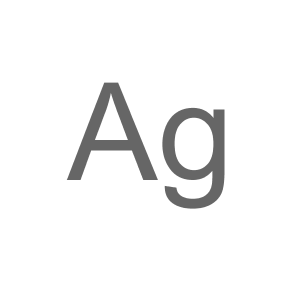Title: Silver
CAS Registry Number: 7440-22-4
Literature References: Ag; at. wt 107.8682; at. no. 47; valence 1, 2. Group IB (11). Occurrence in the earth's crust: 0.1 ppm; also present in seawater: 0.01 ppm. Natural isotopes: 107 (51.35%); 109 (48.65%); artificial isotopes (mass numbers): 100-106, 108, 110-117. One of the earliest known metals. Found native or associated with copper, gold and lead. Principle ores are
argentite,
cerargyrite or
horn silver (mixture of halides),
proustite (3Ag2S.As2S3),
pyrargyrite (Ag2S.Sb2S3). Extraction from ores: Percy
et al., cited by Mellor,
A Comprehensive Treatise on Inorganic and Theoretical Chemistry 3, 301 (1928);
Silver, Its Economics, Extraction, Use, A. Butts, C. D. Coxe, Eds. (Van Nostrand, Princeton, 1967) 480 pp.
Reviews: Thompson, "Silver" in
Comprehensive Inorganic Chemistry vol. 3, J. C. Bailar, Jr.
et al., Eds. (Pergamon Press, Oxford, 1973) pp 79-128; G. H. Sistare and H. B. Lockhart in
Kirk-Othmer Encyclopedia of Chemical Technology vol. 21 (Wiley-Interscience, New York, 3rd ed., 1983) pp 1-32. Review of toxicology and human exposure:
Toxicological Profile for Silver (PB91-180430, 1990) 157 pp.
Properties: White metal, face-centered cubic structure. More malleable and ductile than any other metal except gold; excellent conductor of heat and electricity. mp 960.5°. bp ~2000°. d15 10.49. Not attacked by water or atmospheric oxygen; blackened by ozone, by hydrogen sulfide, by sulfur. Inert to most acids; readily reacts with dil nitric acid, hot concd sulfuric acid; superficially attacked by hydrochloric acid. Sol in fused alkali hydroxides in presence of air, in fused alkali peroxides, in alkali cyanides in presence of air or oxygen. Most silver salts are light-sensitive.
Melting point: mp 960.5°
Boiling point: bp ~2000°
Density: d15 10.49
CAUTION: Potential symptoms of overexposure to dust are blue-gray eyes, nasal septum, throat and skin; irritation and ulceration of skin; GI disturbance.
See NIOSH Pocket Guide to Chemical Hazards (DHHS/NIOSH 97-140, 1997) p 280. Blue-gray discoloration, known as argyria or argyrosis, results from chronic exposure to silver or silver salts.
See Patty's Industrial Hygiene and Toxicology vol. 2A, G. D. Clayton, F. E. Clayton, Eds. (Wiley-Interscience, New York, 3rd ed., 1981) pp 1881-1894.
Use: For coinage, most frequently alloyed with copper or gold; for manuf tableware, mirrors, jewelry, ornaments; for electroplating; for making vessels and apparatus used in manuf medicinal chemicals, in processing foods and beverages, in handling organic acids; as catalyst in hydrogenation and oxidation processes; as ingredient of dental alloys. Has been used for purification of drinking water because of toxicity to bacteria and lower forms of life. Some salts used in photography.

